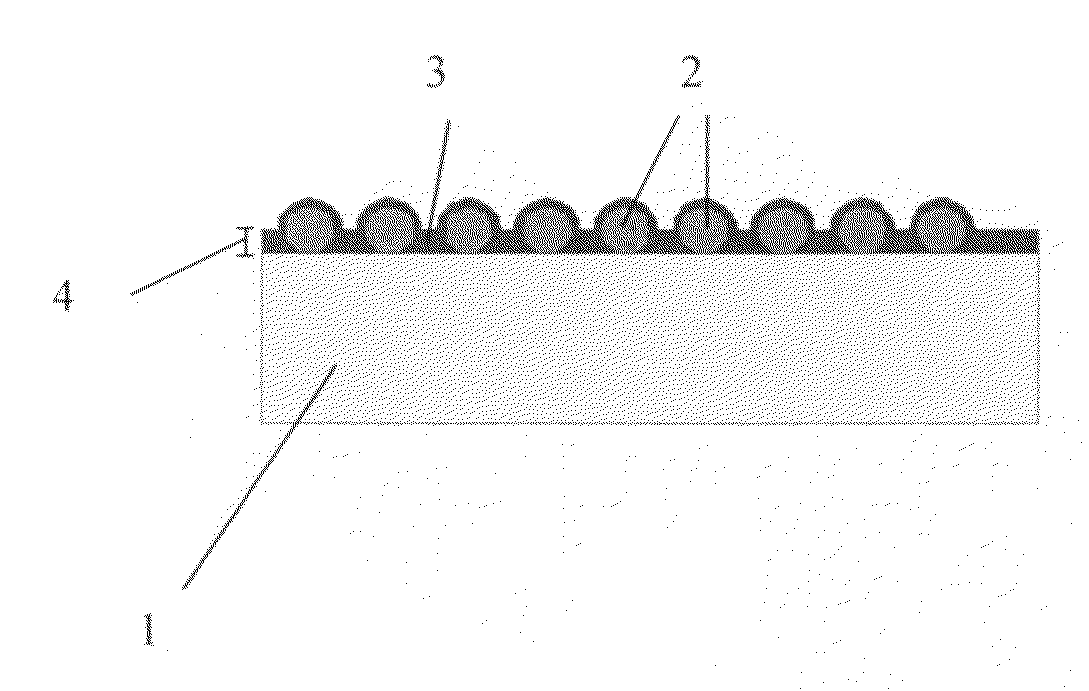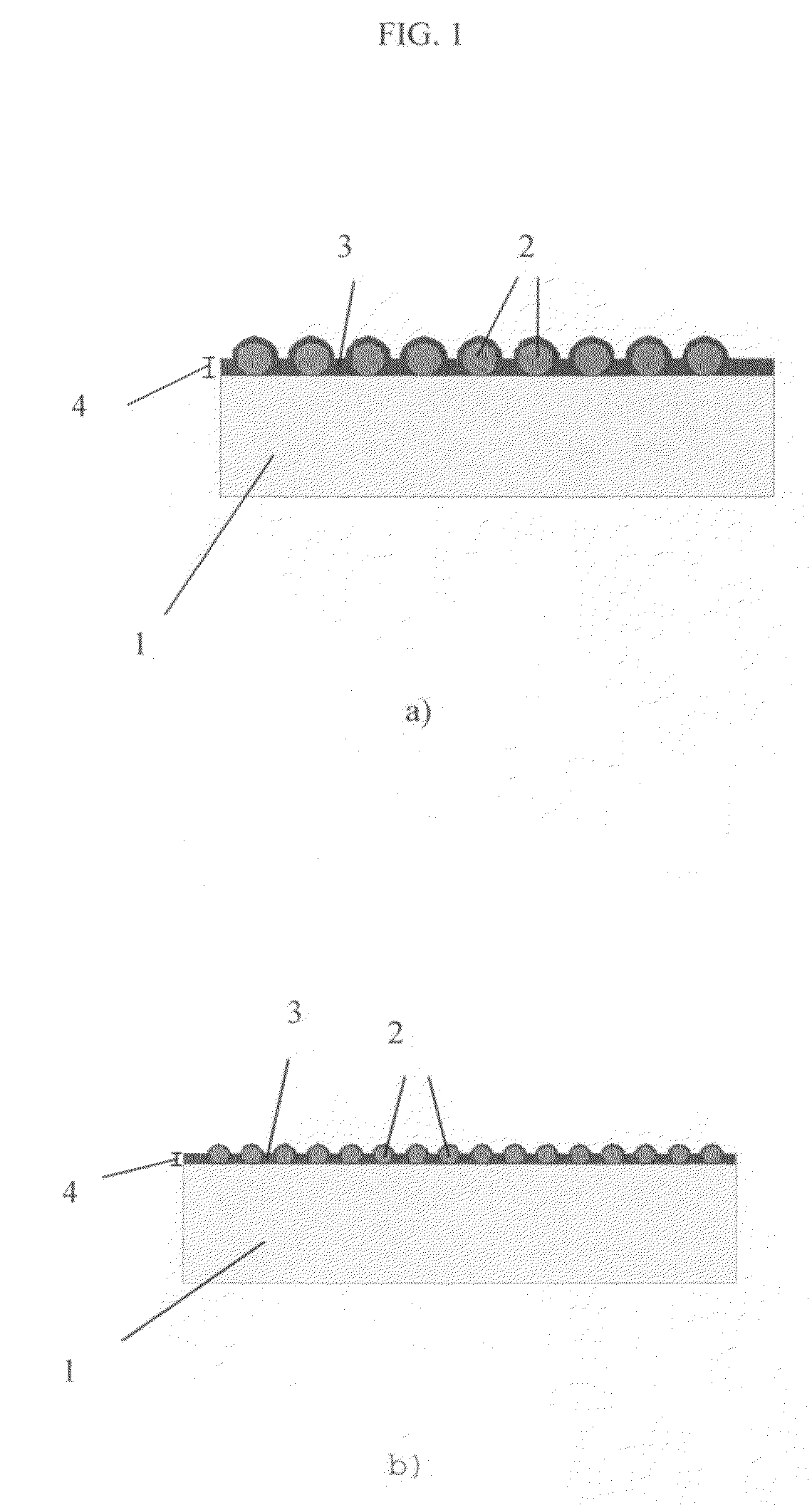Structured coatings for implants and process for the preparation thereof
- Summary
- Abstract
- Description
- Claims
- Application Information
AI Technical Summary
Benefits of technology
Problems solved by technology
Method used
Image
Examples
example 1
Coating with a Hydroxyl Apatite Filler
[0073]69.5 g of tetrabutoxy titanate were dissolved in 500 g of n-butanol at room temperature and were stirred for 2 hours. 17.1 g (corresponding to 3% by weight) of commercial calcium phosphate powder (Merck, D50<2 μm) was subsequently added in portions, based on the total weight of the sol provided (569.5 g). 1% by weight of a dispersant (DB194, anhydrous; Byk Chemie, Wesel) was added for the purposes of dispersion and was stirred for a further 2 hours.
[0074]The glass test specimen was subsequently coated by dipping said test specimen with a withdrawal speed of 1.5 mm / s. It was subsequently dried at room temperature for 1 hour and the coating was ceramised (calcined) at 500° C. for 10 minutes. An electron microscope image of the coating is shown in FIG. 2b).
[0075]Preparations containing 1% by weight and 8% by weight of calcium phosphate powder instead of 3% calcium phosphate powder were produced in accordance with the above description and wer...
example 2
Coating with a Titanium Oxide Filler
[0077]41.7 g of tetrabutoxy titanate were dissolved in 300 g of n-butanol at room temperature and were stirred for 2 hours. 1.71 g (corresponding to 0.5% by weight), 10.26 g (corresponding to 3% by weight), and 20.52 g (corresponding to 6% by weight), based on the total weight of the sol provided (341.7 g), of commercial titanium oxide powder (Alfa Aesar, Karlsruhe; D50: 0.3 μm) were added in portions. 1% by weight of a dispersant (DB194, anhydrous; Byk Chemie, Wesel) was added for the purposes of dispersion and was stirred for a further 2 hours.
[0078]The glass test specimen was subsequently coated by means of dipping with a withdrawal speed of 1.5 mm / s. It was subsequently dried at room temperature for 1 hour and the coating was ceramised at 500° C. for 10 minutes. Coatings were applied to TiAl6V4, titanium, a stainless steel, zirconium oxide and the plastics material polymethyl methacrylate (PMMA) in accordance with Example 2 specified above. Th...
example 3
Description of the Mode of Action
[0079]In order to demonstrate the mode of action of the powder-filled coating, glass substrates (plates, diameter 14.5 mm) were provided with coatings in accordance with Example 1 which contained different amounts of commercial calcium powder (Merck, D50<2 μm). The release of calcium under physiological conditions was determined on the one hand and the cell growth on the surfaces obtained was determined as a function of the powder filling on the other.
Calcium Content Measurement:
[0080]The calcium concentration was determined by means of a photometric test. This involves the formation of a complex by the reaction of o-cresolphthalein complexone (CPC, Fa. Fluka) with calcium at an alkaline pH. The purple colour of the colour complex formed is measured absorptively at 575 nm. The CPC reagent is prepared as follows: 625 mg of 8-hydroxy quinoline (Fluka) were dissolved in 25 ml dimethyl sulphoxide (Serva), then 10 mg o-cpc and 250 μl 36% HCl (Fluka) were ...
PUM
| Property | Measurement | Unit |
|---|---|---|
| Temperature | aaaaa | aaaaa |
| Temperature | aaaaa | aaaaa |
| Length | aaaaa | aaaaa |
Abstract
Description
Claims
Application Information
 Login to View More
Login to View More - R&D
- Intellectual Property
- Life Sciences
- Materials
- Tech Scout
- Unparalleled Data Quality
- Higher Quality Content
- 60% Fewer Hallucinations
Browse by: Latest US Patents, China's latest patents, Technical Efficacy Thesaurus, Application Domain, Technology Topic, Popular Technical Reports.
© 2025 PatSnap. All rights reserved.Legal|Privacy policy|Modern Slavery Act Transparency Statement|Sitemap|About US| Contact US: help@patsnap.com



